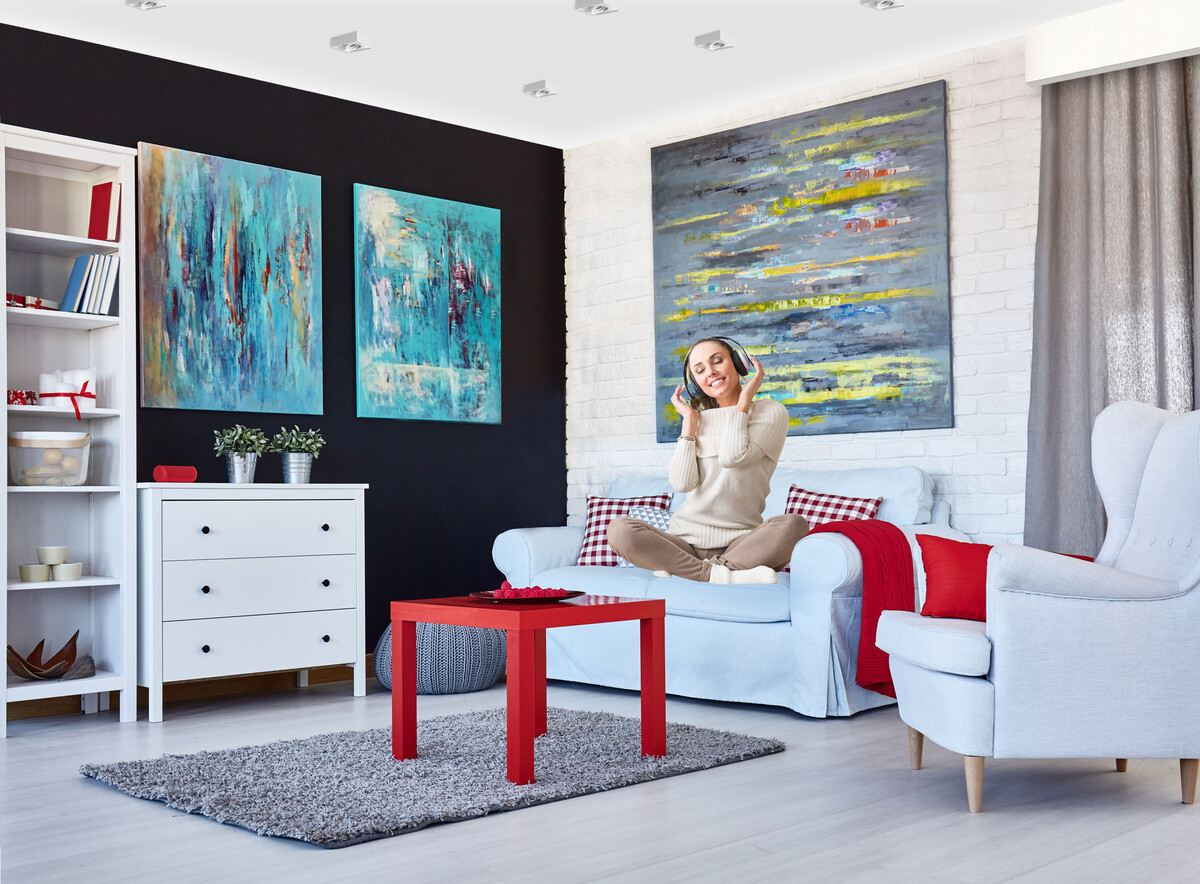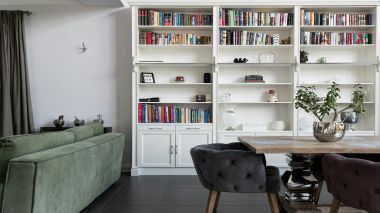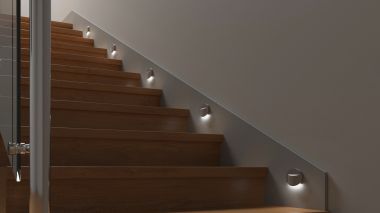The effect of light on human well-being
how does light affect the way we feel, and why should we plan lighting in our homes? Read about it on the blog.

According to scientists, the amount of light during the day is one of the factors affecting human well-being. It can be easily noticed from spring to autumn when the days are long, there is plenty of sunlight and the level of satisfaction with life increases. It all changes with the arrival of winter. We should know that just like natural light, artificial lighting also has an impact on how we feel.
Did you know that...?
Light stimulates the production of serotonin, which is known as the hormone of happiness, and melatonin, which regulates our sleep and wakefulness. Reduced amount of light causes fluctuations in the level of cortisol - the stress hormone - which makes us feel drowsy. These aren't the only aspects of our life affected by light. Light supports human metabolism and helps us maintain a healthy weight. It also keeps our eyes in good shape.
Natural and artificial light
The good news is that the dynamics of daylight can be to a significant degree recreated with the use of lighting. When it is similar to natural light - it makes us feel better.
See also: Creating space with the use of light
The natural rhythm of the day begins at sunrise, with the warm light of the morning that gradually reaches its daylight colour, approx. 6, 500 K. The colour temperature of light decreases around 2 PM. At noon and in the afternoon the amount of blue light significantly decreases and warm colours begin to dominate.
The colour of light and the way we feel
The colour of light should be the most important parameter when we are choosing lighting (colour temperature expressed in Kelvin)
● Cool white (CW - 5,000 to 6,500 Kelvin), it invigorates and helps concentration.
● Neutral white (NW - 3,500 - 4,000 Kelvin), intermediate colour, matching the colour of the natural light in the afternoon. It has a neutral effect on humans.
● Warm white (WW - 2,700 - 3,300 Kelvin), it makes it easier to rest and puts us in a state of relaxation; it is the colour observed at sunrise and sunset.
Now you know how to properly select the colour of light for your rooms.
● Bedroom - the warm colour (it will improve the quality of your sleep and make your rest effective).
● Hallway - the warm colour (it will make these rooms look cosier).
● Office - the cold colour (it will help you concentrate).
● Rooms with a lot of traffic: kitchen, bathroom, living room, workshop - the neutral colour (it renders the colours of objects in the most realistic way and will be helpful during everyday care and makeup).
● Children's room - the colour of the light should depend on the age of the child. The optimal colour for a pupil - especially at the desk - will be cold, and warm colour will help your child fall asleep in the evening.
Using the Kanlux XLED STEP CCT bulb, you can easily change the colour of the light, regardless of the time of the day.With its help, you will be able to create a cosy atmosphere in your interior that will help you relax in the evening, or select a colour that will increase your concentration during the day. With just a few clicks of the light switch, the colour emitted by the bulb will change (from cold, through neutral, to warm).
Remeber!
Adjust your light sources to the needs of your child. Studying at the desk requires an additional source of light that will help avoid eye fatigue, headaches and will make learning effective. Choose a desk lamp in which you can change the colour of light from cold, used while studying, to warm - for an evening's rest.
How to plan the lighting?
You can choose lighting that will positively impact the way you feel. For example, artificial LED lighting, which is similar to the morning light, can increase the level of cortisol, enhancing resistance to stress. Such lighting is stimulating. The cold colour accelerates the rhythm of the day and improves your functioning during the day.
In the evening, it's best to choose the warm colour of lighting that will help you relax. It increases melatonin production in the organism and lowers blood pressure, preparing your body for sleep.
Remember that during the fall and winter season it is particularly important to be surrounded with light that is as similar to the natural rhythm of the day as possible. The sun rises and sets later, so with proper lighting we can stay productive for a longer time.
Did you know that working in front of a computer, using smartphones and watching television before sleep is not good for the human body? The light emitted by these devices keeps brain activity at a high level which can make falling asleep difficult?
Safe light
Make sure that the bulbs you are choosing are compliant with the standards of photobiological safety. According to PN-EN 62471:2010, there are four hazard groups. The risk-free group means that there is no photobiological hazard. Risk Group 1 means that there is no photobiological hazard under normal conditions of use. Risk Group 2 means that there is no photobiological hazard associated with the reaction of the eye to bright sources of light. The final risk group, Group 3, means that photobiological hazard occurs even during a short exposure, and the bulb should not be used.
What are the hazards associated with the use of light sources that are not compliant with the standards?
● Hazard to the eye and skin from actinic UV radiation.
● Hazard to the eye from UV-A radiation.
● Hazard to the eye from blue light.
● Hazard to the eye from infrared (IR).
● Thermal risk to the skin.
● Thermal risk to the retina.
Even though photobiological safety is one of the basic requirements included in European directives, many marketed light sources do not comply with these standards. Make sure that you are using bulbs and lamps from renowned manufacturers, with certificates of marketing authorization.
For women who do their makeup it is important that the colour of their skin in the mirror is natural so that they are able to choose the right shade of foundation. I advise against using traditional bulbs which have a very short lifespan, produce yellowish light, consume a lot of energy and get very hot. Traditional fluorescent lights, flickering on the ceiling, are also quite inconvenient. LED lighting, on the other hand, is long-lasting and highly energy-efficient. It enables us to select the adequate colour that will render the natural colour of our face. The IQ-LED GU10 bulbs with CRI exceeding 95 and a neutral colour of the light will be perfect.

Colours and artificial light
Apart from the colour of the light, we should also pay attention to the colour rendering index (Ra) which is expressed by a number between 0 and 100.
The colour rendering index (CRI/Ra) of your bulbs should be as close to 100 as possible - this is when the light renders the original colours of objects. You will notice it in your dressing room, looking at your clothes and shoes, but you will also see it in the bathroom.
When you are designing lighting, you should remember to make it as similar to daylight as possible. Thanks to that you will support the biological processes occurring in your body. Select bulbs and lamps which are suitable for particular rooms and meet your needs.
Other articles
 How to light your home library and reading space?
How to light your home library and reading space?
Reading is one of those activities that truly allows you to pause—to break away from everyday life...
 Lighting for Mezzanine Floors and High Spaces — Challenges and Solutions
Lighting for Mezzanine Floors and High Spaces — Challenges and Solutions
Not every space has the grandeur of a cathedral — and that is quite fortunate. Low interiors, mezzanine...
 Staircase and Corridor Lighting — Safety and Design
Staircase and Corridor Lighting — Safety and Design
Stairs, corridors and other passageways have specific lighting requirements. This is not only for safety...
 Smart lighting management in your home – where to start?
Smart lighting management in your home – where to start?
Smart lighting systems are not only a matter of convenience, but also a conscious step towards better...
 How does LED lighting work?
How does LED lighting work?
The LED lighting in our homes, offices and public areas is here to stay. Today, it is hard to imagine...
 How can lighting create a spa atmosphere in your bathroom?
How can lighting create a spa atmosphere in your bathroom?
When designing a bathroom, not only aesthetics but also lighting matter—when selected appropriately,...